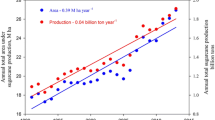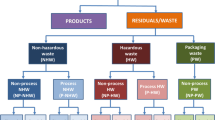Abstract
The winemaking process involves the generation of a significant amount of waste and wastewater. These residues should be addressed for recycling or treatment before being returned to environment. As each winery is unique in waste generation and disposal, plans for environmentally friendly waste management are not universal and should be tested for their effectiveness. In this study, a diagnostic was made during three years, in different wineries, throughout Portugal, in order to quantify and characterize the waste and the wastewater produced. The results showed that solid waste and wastewater are mainly produced during the harvest period, corresponding to 74% and 87%, respectively. One ton of processed grape approximately produce 0.13 t marc, 0.06 t lees, 0.03 t of stalks and 1.65 m3 of wastewater. No significant differences (P⩽0.05) were observed for grape marc, lees and wastewater ratios, between years or wineries. With respect to the stalk ratio, there was no effect of year but the winery significantly affected this ratio (P⩽0.05). During the study period the treated wastewater, since diluted, revealed suitable characteristics for irrigation representing an additional source of water. In this regard, the data acquisition and consolidation ensure the transfer of information and experience which constitute an essential step in a support decision tool design.
Similar content being viewed by others
References
Boudouropoulos I, Arvanitoyannis I S. Current state and advances in the implementation of ISO 14000 by the food industries. Comparison of ISO 14000 to ISO 9000 to other environmental programs. Trends in Food Science & Technology, 1999, 9(11–12): 395–408
Boudouropoulos I, Arvanitoyannis I. Potential and perspectives for application of environmental management system (EMS) and ISO 14000 to food industries. Food Reviews International, 2000, 16(2): 177–237
Hanjra M A, Blackwell J, Carr G, Zhang F, Jackson T M. Wastewater irrigation and environmental health: implications for water governance and public policy. International Journal of Hygiene and Environmental Health, 2012, 215(3): 255–269
Kumar A, Christen E. Developing a Systematic Approach to Winery Wastewater Management. Final Report to Grape and Wine Research and Development Corporation, Project Number: CSL05/02. CSIRO ed. series ISSN: 1834-6618, 2010. Available online at http://www.gwrdc.com.au/ (accessed September 18, 2013)
Andreottola G, Foladori P, Ziglio G. Biological treatment of winery wastewater: an overview. Water Science and Technology, 2009, 60(5): 1117–1125
Eusébio A, Mateus M, Baeta-Hall L, Almeida-Vara E, Duarte J C. Microflora evaluation of two agro-industrial effluents treated by the JACTO jet-loop type reactor system. Water Science and Technology, 2005, 51(1): 107–112
Oliveira M, Queda C, Duarte E. Aerobic treatment of winery wastewater with the aim of water reuse Water Science and Technology, 2009, 60(5): 1217–1223
Arvanitoyannis I S, Ladas D, Mavromatis A. Potential uses and applications of treated wine wastes: a review. International Journal of Food Science & Technology, 2006, 41(5): 475–487
Santamaría B, Salazar G, Béltran S, Cabezas J L. Membrane sequences for fractionation of polyphenolic extracts from defatted milled grape seeds. Desalination, 2002, 148(1–3): 103–109
Yalcin D, Ozcalik O, Altiok E, Bayraktar O. Characterization and recovery of tartaric acid from wastes of wine and grape juice industries. Journal of Thermal Analysis and Calorimetry, 2008, 94(3): 767–771
Alonso A M, Guillén D A, Barroso C G, Puertas B, García A. Determination of antioxidant activity of wine byproducts and its correlation with polyphenolic content. Journal of Agricultural and Food Chemistry, 2002, 50(21): 5832–5836
Lafka T I, Sinanoglou V, Lazos E S. On the extraction and antioxidant activity of phenolic compounds from winery wastes. Food Chemistry, 2007, 104(3): 1206–1214
Sakata Y, Zhuang H, Kwansa H, Koehler R C, Doré S. Resveratrol protects against experimental stroke: putative neuroprotective role of heme oxygenase 1. Experimental Neurology, 2010, 224(1): 325–329
Pedroza M A, Carmona M, Alonso G L, Salinas M R, Zalacain A. Pre-bottling use of dehydrated waste grape skins to improve colour, phenolic and aroma composition of red wines. Food Chemistry, 2013, 136(1): 224–236
Arvanitoyannis I S, Ladas D, Mavromatis A. Wine waste treatment methodology — review article. International Journal of Food Science & Technology, 2006, 41(10): 1117–1151
Devesa-Rey R, Vecino X, Varela-Alende J L, Barral M T, Cruz J M, Moldes A B. Valorization of winery waste vs. the costs of not recycling. Waste Management (New York, N.Y.), 2011, 31(11): 2327–2335
Silva C F, Arcuri S L, Campos C R, Vilela D M, Alves J G L F, Schwan R F. Using the residue of spirit production and bio-ethanol for protein production by yeasts. Waste Management (New York, N. Y.), 2011, 31(1): 108–114
Bustamante M A, Paredes C, Morales J, Mayoral A M, Moral R. Study of the composting process of winery and distillery wastes using multivariate techniques. Bioresource Technology, 2009, 100(20): 4766–4772
Kumar M, Ou Y L, Lin J G. Co-composting of green waste and food waste at low C/N ratio. Waste Management (New York, N.Y.), 2010, 30(4): 602–609
Ruggieri L, Cadena E, Martínez-Blanco J, Gasol CM, Rieradevall J, Gabarell X, Gea T, Sort X, Sánchez A. Recovery of organic wastes in Spanish wine industry. Technical, economic and environmental analyses of the composting process. Journal of Cleaner Production, 2009, 17(9): 830–838
López-Palau S, Dosta J, Mata-Alvarez J. Start-up of an aerobic granular sequencing batch reactor for the treatment of winery wastewater. Water Science and Technology, 2009, 60(4): 1049–1054
Oliveira M, Duarte E. Winery Wastewater Treatment-Evaluation of the Air Micro-Bubble Bioreactor Performance. Mass Transfer book, InTech open access publisher, 2011. Available online at http://www.intechopen.com/books/mass-transfer-advanced-aspects/ (accessed November 12, 2013)
Hidalgo D, Irusta R, Sandoval A, Fiel Á. Development of Tools and Guidelines for the Promotion of the Sustainable Urban Wastewater Treatment and Reuse in the Agricultural Production in the Mediterranean Countries, Task5: Development of Specification for Urban Wastewater Utilization, Project ME8/AIDCO/2001/0515/59341-P033, 2005. Available online at http://www.uest.gr/medaware/index.htm (accessed September 17, 2013)
APHA, AWWA, WEF. Standard Methods for the Examination of Water and Wastewater. 20th edition. Washington, D C, USA: APHA, AWWA, WEF, 2006
Tano F, Valenti L, Failla O, Beltrame E. Effects of distillery vinasse on vineyard yield and quality in the D.O.C. “Oltreoò Pavase Pinot nero” — Lombardy-Italy. In: Proceedings of the 3rd International Specialised Conference on Sustainable Viticulture and Winery Wastes Management, Barcelona. Barcelona, Spain: University of Barcelona Press, 2004, 225–230
Bolzonella D, Rosso D. Winery wastewater characterisation and biological treatment options. In: Proceedings of the 5th International Specialised Conference on Sustainable Viticulture and Winery Wastes Management. Trento andVerona, Italy: University of Verona Press, 2009, 19–26
Lofrano G, Belgiorno V, Mascolo A. Winery wastewater treatment options: drawbacks and advantages. In: Proceedings of the 5th International Specialized Conference on Sustainable Viticulture: Winery Wastes and Ecological Impacts Management, University of Trento, Trento and Verona, Italy. Trento and Verona, Italy: University of Verona Press, 2009, 27–34
Mosse K P M, Lee J, Leachman B T, Parikh S J, Cavagnaro T R, Patti A F, Steenwerth K L. Irrigation of an established vineyard with winery cleaning agent solution (simulated winery wastewater): vine growth, berry quality, and soil chemistry. Agricultural Water Management, 2013, 123: 93–102
Mosse K P M, Patti A F, Christen E W, Cavagnaro T R. Review: winery wastewater quality and treatment options in Australia. Australian Journal of Grape and Wine Research, 2011, 17(2): 111–122
Brissaud F. Criteria for water recycling and reuse in the Mediterranean countries. Dessalination, 2008, 218(1–3): 24–33
Tsagarakis K P, Dialynas G E, Angelakis A N. Water resources management in Crete (Greece) including water recycling and reuse and proposed quality criteria. Agricultural Water Management, 2004, 66(1): 35–47
Hussain I, Raschid L, Hanjra M A, Marikar F, van der Hoek W. Wastewater use in agriculture: review of impacts and methodological issues in valuing impacts. Working Paper 37. Colombo, Sri Lanka: International Water Management Institute, 2002
Mosse K P M, Patti A F, Christen E W, Cavagnaro T R. Winery wastewater inhibits seed germination and vegetative growth of common crop species. Journal of Hazardous Materials, 2010, 180(1–3): 63–70
Bertran E, Sort X, Soliva M, Trillas I. Composting winery waste: sludges and grape stalks. Bioresource Technology, 2004, 95(2): 203–208
Author information
Authors and Affiliations
Corresponding author
Rights and permissions
About this article
Cite this article
Oliveira, M., Duarte, E. Integrated approach to winery waste: waste generation and data consolidation. Front. Environ. Sci. Eng. 10, 168–176 (2016). https://doi.org/10.1007/s11783-014-0693-6
Received:
Accepted:
Published:
Issue Date:
DOI: https://doi.org/10.1007/s11783-014-0693-6




